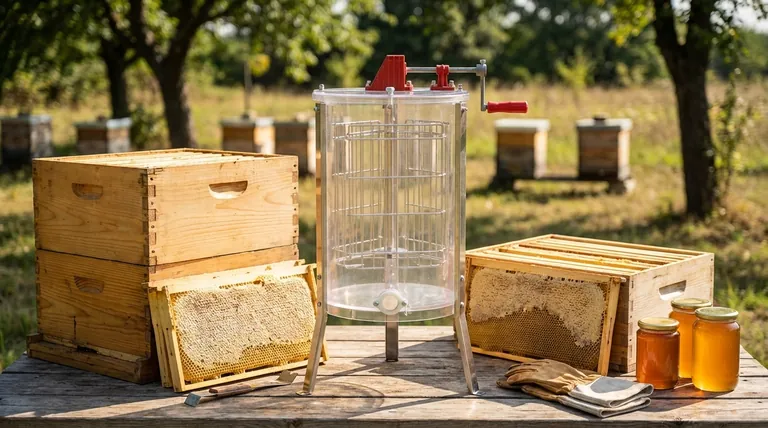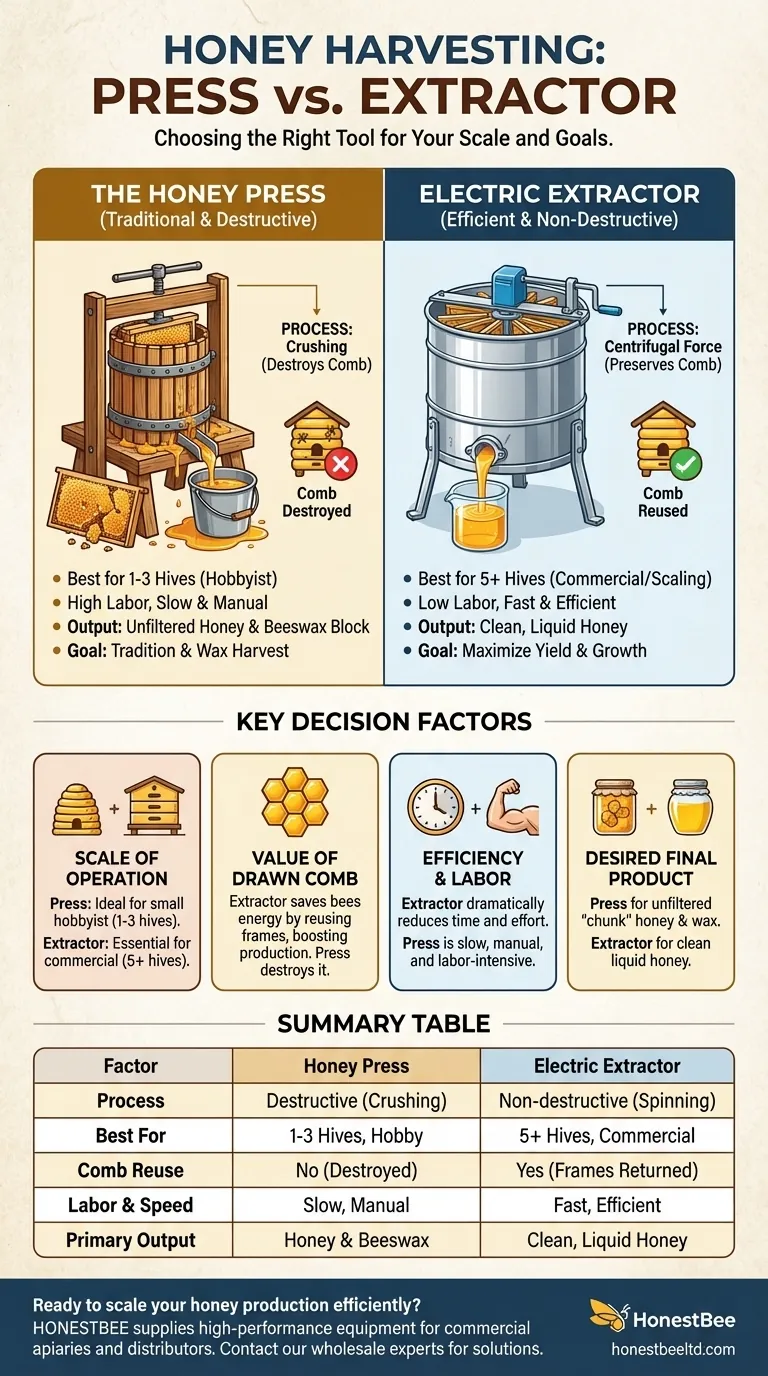At its core, the choice between a honey press and an electric honey extractor hinges on the scale of your operation, your beekeeping philosophy, and whether you want to preserve your honeycombs. A press is a low-tech, destructive method suited for very small-scale hobbyists, while an electric extractor is an efficiency-focused tool for beekeepers who want to save time and reuse their valuable drawn comb.
The decision is less about technology and more about your fundamental goal. A honey press is for the traditionalist harvesting both honey and wax on a small scale. An electric extractor is for the beekeeper focused on maximizing honey yield and minimizing labor by preserving the comb.

The Fundamental Difference: Process and Outcome
Before weighing the factors, it's crucial to understand that these two tools do not perform the same function. They represent two entirely different approaches to harvesting honey.
The Honey Press: Crushing and Straining
A honey press works by crushing the entire honeycomb. The mix of honey, beeswax, pollen, and propolis is squeezed, and the liquid honey drains out, typically through a filter or screen.
This is a destructive process. The comb is destroyed and cannot be returned to the hive. The resulting honey is often unfiltered and contains more pollen and fine wax particles, and you are left with a block of compressed beeswax as a valuable secondary product.
The Electric Extractor: Centrifugal Force
An electric extractor uses centrifugal force to sling honey out of the cells. After the wax cappings are sliced off, the frames are placed in a drum that spins at high speed.
This is a non-destructive process. The comb structure remains perfectly intact. These empty "drawn combs" can then be returned to the hive, giving the bees a massive head start on their next cycle of honey production.
Key Decision Factors for Your Apiary
Your choice will be dictated by a few critical variables. Being honest about your scale and goals will make the decision clear.
Scale of Operation
This is the most significant factor. The number of hives you manage directly correlates to the amount of labor you can tolerate.
A small hobbyist with one to three hives may find a press manageable. For anyone with five or more hives, the time and labor required for a press become prohibitive. An electric extractor can process in minutes what would take hours with a press.
The Value of Drawn Comb
Bees expend enormous energy to produce wax and draw out comb. It is estimated that bees consume 6-8 pounds of honey to produce just one pound of wax.
By using an extractor and returning the empty comb to the hive, you are saving your bees thousands of hours of labor and pounds of honey. This directly translates to a healthier, more productive colony and a larger honey surplus for you.
Efficiency and Labor
An electric extractor is a tool of efficiency. It dramatically reduces the physical effort and time spent in the honey house, freeing you to focus on other aspects of beekeeping.
A press is a slow, manual, and often messy process. While satisfying for some, it is not a practical solution for harvesting more than a few frames at a time.
Desired Final Product
If your goal is to produce unfiltered, "chunk" honey or to maximize your beeswax harvest, a press is a direct route to that outcome. The process inherently separates the wax from the honey.
If your goal is to produce clean, liquid honey with minimal filtering, an extractor is superior. The honey is flung cleanly from the cells, leaving most debris and wax behind in the frame.
Understanding the Trade-offs
Neither tool is universally "better"; they are optimized for different goals and come with clear compromises.
The Honey Press: Tradition vs. Productivity
A press is a simple, often less expensive machine that requires no electricity. It aligns with a more traditionalist view of beekeeping and is effective for top-bar or Warre hives where comb is not on a reusable frame.
The primary drawback is its destructive nature. Destroying the comb forces your bees to start from scratch, significantly reducing the hive's potential honey output for the season.
The Electric Extractor: Investment vs. Return
An electric extractor is a significant investment, requiring a higher upfront cost and access to power. The machines are larger, heavier, and require more thorough cleaning.
However, the return on this investment is immense. The time saved is substantial, and the ability to reuse drawn comb fundamentally increases your apiary's honey production capacity. For any serious or growing beekeeper, it is not a luxury but a necessary tool for sustainable growth.
Making the Right Choice for Your Goal
Evaluate your primary motivation to find your answer.
- If your primary focus is a traditional hobby with 1-3 hives: A honey press is a viable and low-cost method that also provides a significant beeswax harvest.
- If your primary focus is growth and efficiency (5+ hives): An electric extractor is a non-negotiable investment that will pay for itself in saved time and increased honey yield.
- If your primary focus is maximizing your honey harvest: An electric extractor химиis the only choice, as reusing drawn comb is the single biggest factor in boosting hive productivity.
- If your primary focus is creating a secondary product from beeswax: A honey press is the most direct way to separate large quantities of wax during your harvest.
Ultimately, choosing the right tool is about aligning your equipment with the scale and philosophy of your beekeeping journey.
Summary Table:
| Factor | Honey Press | Electric Extractor |
|---|---|---|
| Process | Destructive (crushing) | Non-destructive (spinning) |
| Best For | 1-3 hives, traditional hobbyists | 5+ hives, commercial apiaries |
| Comb Reuse | No, comb is destroyed | Yes, frames are returned to hive |
| Labor & Speed | Slow, manual, high labor | Fast, efficient, low labor |
| Primary Output | Honey & beeswax block | Clean, liquid honey |
Ready to scale your honey production efficiently?
For commercial apiaries and beekeeping equipment distributors, choosing the right harvesting equipment is critical for productivity and profitability. HONESTBEE supplies the durable, high-performance electric honey extractors and beekeeping supplies that serious beekeepers rely on to maximize their yield and minimize labor.
Contact our wholesale experts today to discuss the best equipment solutions for your operation's scale and goals.
Visual Guide

Related Products
- HONESTBEE 3-Frame Manual Acrylic Honey Extractor
- Commercial Electric 12 Frame Honey Extractor Spinner Motorized Honey Extractor
- 6 Frame Manual Stainless Steel Honey Extractor Beekeeping Equipment
- Electric 8 Frame Honey Spinner Extractor Equipment for Beekeeping
- 40 Frame Commercial Electric Honey Extractor for Beekeeping
People Also Ask
- What size honey extractor do I need? Match Frame Capacity to Your Hives for Maximum Efficiency
- What equipment is used for honey harvest? Essential Tools for Every Beekeeper
- How do you collect honey at home? A Beginner's Guide to Harvesting from Your Hive
- What is a fun and easy alternative to using a honey extractor for harvesting honey? Try the Crush and Strain Method
- What is the most common method for cleaning a honey extractor? Protect Your Honey & Equipment



















